ACUPRESSURE FOR LABOR PAIN
Acupressure for labor pain
Acupressure is based on the principles of acupuncture, which is a form of Traditional Chinese Medicine. It involves the application of pressure to specific points on the body. It is not massage, but rather a direct, firm pressure to a specific area. You can use your fingers, thumbs, knuckles, elbows, the blunt end of a pencil or pen or other hard, round objects.
In acupressure, there are twelve invisible lines called meridians that run along each side of the body. The meridians exist in pairs, and each pair corresponds to a specific organ. Acupressure points are named for the meridians they lie on, and each is given a number according to where along the meridian it falls.
Acupressure can be used to provide pain relief and calm the birthing woman as well as encourage an efficient labor.
If you plan on using acupressure during your labor, practice it beforehand – and often. All the points are safe from week 37 on, but you’ll want to use less pressure than you would during your labor. When you’re in labor, you want to press firmly on the point. The sensation should be tolerable but you should definitely feel a strong pressure. You might feel pressure, heaviness or even an electrical sensation on the point. Make you check with your midwife or doctor before trying acupressure.
It is vital that you start using acupressure in the early stages of labor and continue at regular intervals to help the success of acupressure in the intense, later stages of labor.
When your support person is giving you acupressure, keep experimenting and giving feedback about what’s working the best as far as the amount of pressure and even the points that you like the most.
The Acupressure Points
There are several points where pressure can be applied for pain relief and for an efficient birth. Again, make sure there is direct, firm pressure on the points. Everyone is different on how long they like the points to be held for and how often. This is completely up to the laboring woman.
Large Intestine 4
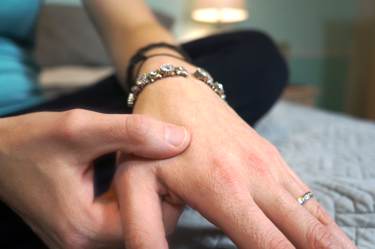 This point is great to help get labor started and the woman is able to press this point herself. It’s generally helpful for her to start pressing this point at the beginning of labor (or even before it begins in the last couple weeks of pregnancy). This point is often useful when the woman starts to get the urge to push.
This point is great to help get labor started and the woman is able to press this point herself. It’s generally helpful for her to start pressing this point at the beginning of labor (or even before it begins in the last couple weeks of pregnancy). This point is often useful when the woman starts to get the urge to push.
Lower Back Points
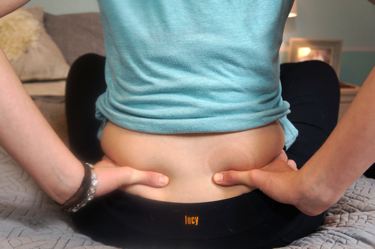 The lower back points are extremely helpful if you are experiencing back labor or in the middle of an intense contraction as a counter pressure. These points are located in the lower back region and can be individualized to the laboring woman depending on where it feels the best to her. Sometimes the the point might be more outwards on the lower back. Have your support person push into the points with their knuckles and lean in with their body weight during a contraction.
The lower back points are extremely helpful if you are experiencing back labor or in the middle of an intense contraction as a counter pressure. These points are located in the lower back region and can be individualized to the laboring woman depending on where it feels the best to her. Sometimes the the point might be more outwards on the lower back. Have your support person push into the points with their knuckles and lean in with their body weight during a contraction.
Kidney 1
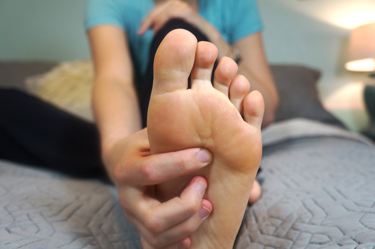 This point is located in the center of sole of the foot in the depression next to the bottom of the ball of the foot. These points pull energy downward and are typically useful during the transition phase of labor. This is also a great point for calming to help with stress and anxiety. You can also use sea bands around the foot to place the pressure on the point for you.
This point is located in the center of sole of the foot in the depression next to the bottom of the ball of the foot. These points pull energy downward and are typically useful during the transition phase of labor. This is also a great point for calming to help with stress and anxiety. You can also use sea bands around the foot to place the pressure on the point for you.
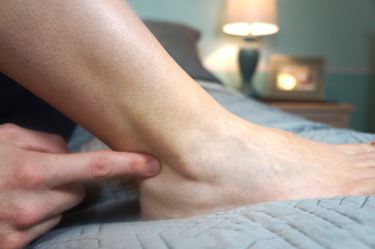
Urinary Bladder 60
This point is generally used to increase circulation and provide pain relief in the body. Most women also like this point during the transitional phase of labor.
Spleen 6
This point is located on the inner calf about four fingers width up along the tibial bone. There will be a tender spot, so find that. In case of a stalling labor, use this point along with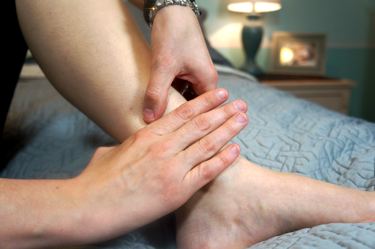 large intestine 4 to encourage stronger contractions. Have the woman apply pressure to the hand point and the support person give acupressure to spleen 6.
large intestine 4 to encourage stronger contractions. Have the woman apply pressure to the hand point and the support person give acupressure to spleen 6.
You’ll have to experiment with each of these points to see which ones feel the best. What felt the best during pregnancy might not be the one that feels the best during labor and they could also change depending on what phase of labor you’re in.


